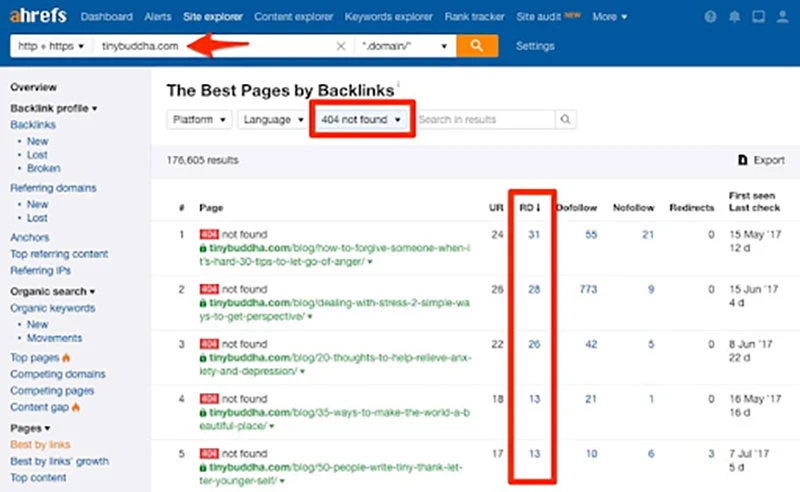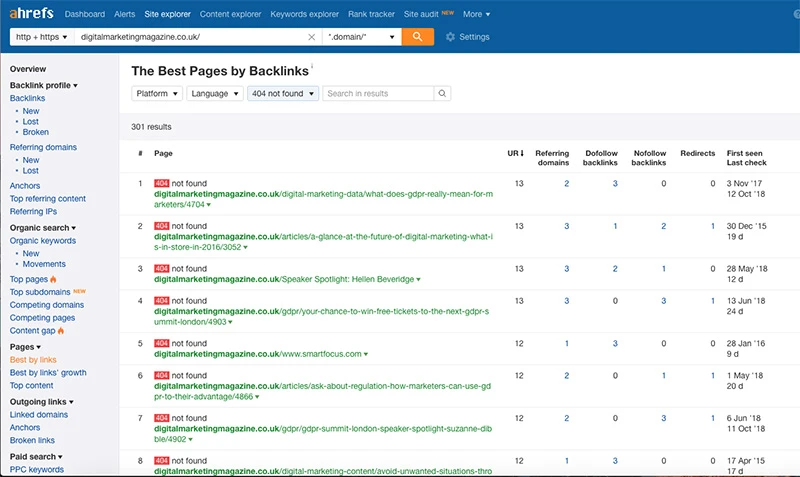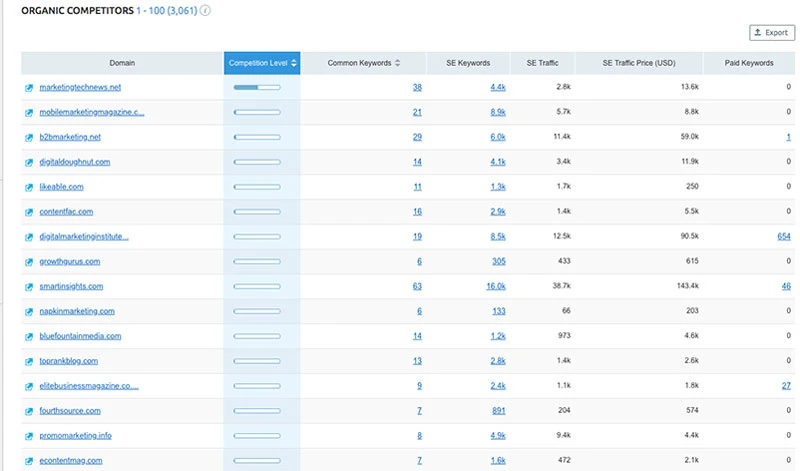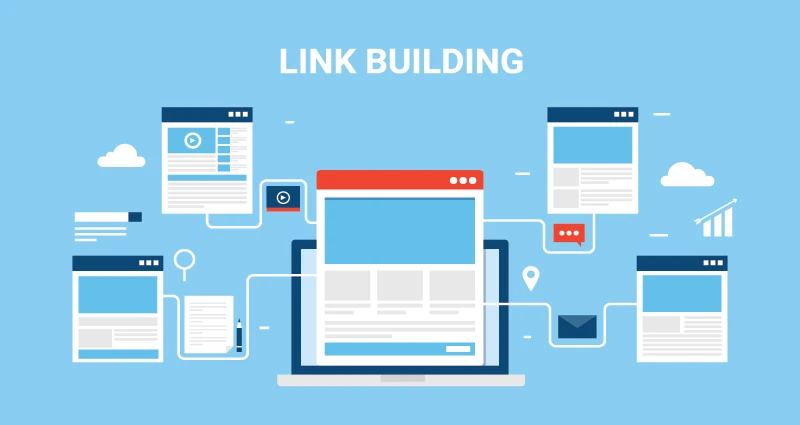It’s common knowledge that backlinks are one of the most significant ranking factors for search engines. In fact, a recent study by Backlinko found that external backlinks correlated more with top-ranking pages than any other ranking factor. Building a strong link profile is therefore essential to any SEO strategy and should be a key priority for any website owner.
This said, link-building is all about quality over quantity. There’s no point in acquiring a load of links from websites that are deemed to be unreputable by Google. These are considered as low quality links that simply won’t benefit your online visibility.
So, we’ve come up with six steps that you can take to build high-quality backlinks from authoritative sites and climb above your competitors in search engine rankings.
Step 1: Fix your broken links
What [is it]
First things first, let’s start with the easiest link-building method of all - repairing broken inbound links. This is essentially all about fixing the links you’ve already earned, so it requires very little effort at all.
Why [is it important]
Broken links occur when previously acquired backlinks point to web pages that have been updated or removed. When this happens, a click of the link will drive you straight into a 404 error-shaped wall. They can also occur if the referral site makes a mistake when linking to you (e.g adding an extra character to the URL). Broken links shouldn’t be forgotten about, and should always be monitored as they are easy to lose and even easier to fix.
How [to do it]
In order to repair your links, you’ll need to make use of software such as Ahrefs, SEMrush or Majestic. These will all have a link auditing tools that will crawl your backlinks and show you which links are broken or have been recently lost. Once found, you’ll need to redirect (301) these links to a new location. This could be to an updated version of the same page, or one that is similar in terms of content or category.

E.g.
Old (broken) link:
www.foodsite.co.uk -> www.italianrestaurant.co.uk/10-pizza-base-recipes-for-2017 … leads to a 404 error
New (repaired) link:
www.foodsite.co.uk -> www.italianrestaurant.co.uk/10-pizza-base-recipes-for-2017 -> www.italianrestaurant.co.uk/10-pizza-base-recipes-for-2018 … The URL has been updated
Step 2: Be a link Samaritan
What
Now you’ve repaired your own link profile, you can go ahead and do exactly the same to other websites - just with a slight difference. Instead of reclaiming previously earned links, this time you’re seeking to gain new ones through the power of persuasion (and through being a good Samaritan). The idea is that you inform the webmaster of their broken links and conveniently suggest other websites (i.e yours) that they can link to.
Why
By making other websites aware of their broken links, you are not only doing them a favour, but you are also developing a relationship that can be mutually beneficial in the future. More often than not, the web owners will appreciate you reporting the broken link(s), and trade out the old link for your new one. This is incredibly simple for them to do, and if the referring website has a reasonably high domain authority, then this is a very worthwhile link-building method.
How
You can audit the link profiles of other websites just like you would your own. Just input the URL into a backlink auditing tool and you will be presented with a list of its broken links.
The next step is to sift through and find links to pages that are similar to the content you offer on your site. Then all you need to do is contact the website owner, report the broken link and provide a link to your web page or blog as a helpful alternative.
The trick here is to be helpful. If you’re helpful, they’re more likely to reward you with you the link. Of course this isn’t the case for all sites, so you may have to be patient until you find the right one.

Top Tip
Use Ahrefs: Site Explorer > enter a competitor’s site > Best by links > add a 404 filter > sort by RDs
Step 3: Get Guest Posting
What
Guest posting is all about obtaining links by publishing your content on another website. The idea here is that you provide a website with a brilliant piece of content, and in exchange, they’ll agree to link back to you; namely within the body or at the end of the article. It’s a win-win for both parties.
Why
Guest posting is the arguably the best way to expand your exposure online. By publishing articles or blog posts on websites with a high readership, you’ll be able to place your content in front of new audiences; thus enhancing your brand reputation and helping you to establish a brand voice.
Whilst it may be true that the primary aim of securing a guest post is to obtain a backlink, it’s also about growing your brand into an online thought-leader. The more content you produce surrounding a certain topic, the more trust consumers will have in your brand, which of course will make them more inclined to use your service(s). Google also values articles that are written by people/brands that they recognise as experts in a certain field.
How
1) Think of a topic/article idea:
Unique content sells itself. You’ll need to put your thinking cap on and come up with an original content idea that not many other people have done before. Granted, it can be difficult to think of a completely new topic, but what you can do is adapt a previously discussed topic by adding your own unique spin or expert insight.
You should also ensure that your article idea is relevant to the website you are promoting; so it may help to jot down a list of keywords you frequently use and think of any relating queries. At the end of the day, your article needs to inform people a well as engage and interest them.
Top Tip
Use the SEMRush Topic Research tool to generate a list of relevant topics relating to your keywords & queries.
2) Locate target websites:
Once you’ve come up with a title, the next step is to find the right place to share it. An easy way of finding target websites is to do a Google search of: “[keywords] + write for us”. Other alternatives include:
- “[keywords] + contribute”
- “[keywords] + submit an article”
- “[keywords] + writers wanted”
- “[keywords] + become a contributor”
- “[keywords] + accepting guest posts”
Note that if you’re looking to secure high quality backlinks, you’ll need to target websites with high domain authority. As a general rule, any site with a DA of below 25 probably it’s worth getting a link from. It’s the 30+ websites that you should focus on if you want that rank boosting ‘link juice’.
Top Tip
Use the SEMRush ‘Competitor Research toolkit’ and input a sample website into ‘Domain overview’ > ‘Main organic competitors’. This will then produce a list of similar websites that host the same keywords; which could prove useful in locating more sites to target for your outreach.

3) Send an email proposing your article idea:
After you’ve compiled a list of target sites and their contact details, it’s time to start the most important part of the outreach process; selling your idea.
It always helps to introduce yourself in a friendly manner, including who you’re writing for and previous articles you may have written in the past. Pitch your idea clearly, and highlight why you think it’ll be a good fit for the prospect’s site or blog. You may also want to compliment similar pieces of content that has previously been published on the site.
Most importantly, be sure to mention that you are looking to supply your unique and wonderful content in exchange for a follow backlink. Some websites will charge a fee for this, but for the most part, if your content is good enough, you’ll be able to secure that all important link for free.
Step 4: Bolster your PR
What
Digital PR is fast becoming a major link-building strategy for a lot of brands. PR link-building is all about collaborating with journalists and influencers who can connect you with a story or piece of content published in press and popular online publications.
Why
Considering the potential in terms of reach, brand exposure and link authority, it’s no surprise so many companies are jumping on the Digital PR bandwagon. Most newspaper or magazine websites have a very high domain authority; which make for a very juicy link. When you combine this with the fact that your brand will also gain publicity and likely earn a lot of referral traffic, Digital PR link-building should be a no brainer.
How
Newspapers and popular online publications can be tricky to get a follow link from, so using influencers can be another great way to earn free or paid PR opportunities.
To do this, you need to Influence the influencers. Great content attracts links - the same concept applies here. It’s all about striking up a good relationship with influencers who specialise in your industry area and enticing them with unique stories and content. Social media should be your weapon of choice here. Browse through Facebook Groups, Twitter (e.g Journorequest), LinkedIn, and also query sites like Quora to find journalists and bloggers to connect with. You may find yourself getting turned down from time to time, but don’t be discouraged, when you eventually get that golden link from a big site, it’s completely worthwhile.
Step 5: Link up your brand mentions
What
Linking up your brand mentions is another very easy link-building method. Essentially, brand mentions are occasions where your company name has been published somewhere online - without an associated link (i.e to your website home page/landing pages). This could be a product listing, or a recent collaboration or sponsorship.
Why
Brand mentions are quick and easy wins, and are far less time consuming than other link-building techniques. Much like repairing your external broken links, these links shouldn’t be too difficult to get. You’ve already earnt your online real estate on the website in question, and people that are already talking about your brand are typically more likely to link. As long as the website doesn’t have a no link policy, you should be able to secure the appropriate backlink without any problem.
How
To find your brand mentions, you can either manually type in your company name in Google and browse the results, or automate the entire process by switching on Google alerts - which you can configure to alert you when your domain or brand name is mentioned. Once you’ve put together a list of unlinked brand mentions, simply contact the website owner and politely request a backlink.
Step 6: Monitor (and steal) your competitor’s links
What
Stealing your competitor’s backlinks can be a very effective way of getting quality links. This process is also pretty simple, and involves spying on your competitor’s link building strategy, monitoring keywords, and preying on their recently acquired backlinks.
Why
As a general rule, if a website links to one of your competitors e.g through publishing a guest article - they’re likely to accept one from you too. At the end of the day, websites need content, and if you are able to provide something similar or better, you should be well on your way to securing some high-quality backlinks. Finding your own guest post opportunities can be difficult and time consuming, so this method (which requires a lot less effort) is definitely worth giving a go.
How
There are a number of tools you can use to monitor your competitor’s links. We recommend Ahrefs, Open Site Explorer, SEMrush, Majestic; all of these have URL backlink crawlers which can produce all sorts of details from a given website’s link profile.
1) Crawl your competitor’s links
Using Ahrefs as an example:
Click on: Site Explorer > enter your competitor’s URL > Backlinks
This will pull up all your competitor’s recently acquired backlinks, displaying a list of referring domains and direct URLs linking to the specific pages. Simply scroll through and make a note of all the authoritative sites that will be a good fit for you and your content. Alternatively, you can export the list into an excel document and analyse from there.
Click on: Site Explorer > enter your competitor’s URL > Organic search > Top pages
Exploring your competitor’s most linked-to pages will give you an idea of the type of content that generates or attracts links to your topics/industry areas. Quality landing pages are much more likely to attract referral links, so it’s important to ensure these are produced to a standard that is worthy of a backlink.
Remember, link-building is all about developing relevant connections that are designed to provide informative answers to user’s search queries. If everything aligns, Google will recognise these connections and will reward your website accordingly.
2) Approach the website owner with a similar content proposition
Much like the outreach process discussed above, contact the most authoritative websites with a content idea that is similar (preferably better) than the piece you competitor has supplied. Easy.
Conclusion
So there you have it, six tried and tested ways to build high quality backlinks. Some are more challenging than others, and although building quality links is no walk in the park, as long as you remain persistent and vigilant, links are always there to be earned.
Remember to stay smart and aim big, make use of the available tools and target those high DA’s. Oh, and don’t forget to monitor your links - retaining them is just as important as earning them!
If you’re looking to boost the visibility of your website, get in touch with our digital experts today and we’ll guide you through our proven step-by-step process to quality link building that yields results both in terms of search engine rankings and brand exposure.
